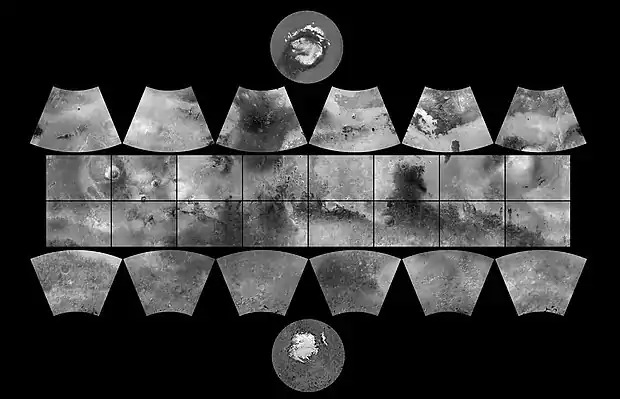Arcadia quadrangle
The Arcadia quadrangle is one of a series of 30 quadrangle maps of Mars used by the United States Geological Survey (USGS) Astrogeology Research Program. The quadrangle is located in the north-central portion of Mars’ western hemisphere and covers 240° to 300° east longitude (60° to 120° west longitude) and 30° to 65° north latitude. The quadrangle uses a Lambert conformal conic projection at a nominal scale of 1:5,000,000 (1:5M). The Arcadia quadrangle is also referred to as MC-3 (Mars Chart-3).[1]
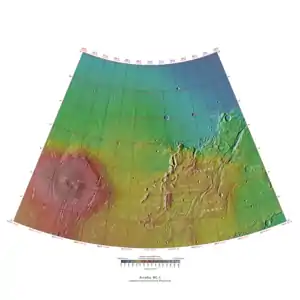 Map of Arcadia quadrangle from Mars Orbiter Laser Altimeter (MOLA) data. The highest elevations are red and the lowest are blue. | |
| Coordinates | 47.5°N 90°W |
|---|---|
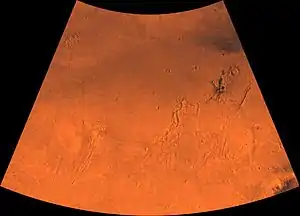
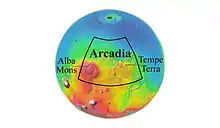
The southern and northern borders of the Arcadia quadrangle are approximately 3,065 km and 1,500 km wide, respectively. The north to south distance is about 2,050 km (slightly less than the length of Greenland).[2] The quadrangle covers an approximate area of 4.9 million square km, or a little over 3% of Mars’ surface area.[3] The region called Tempe Terra is in the Arcadia quadrangle.
Several features found in this quadrangle are interesting, especially gullies which are believed to be caused by relatively recent flows of liquid water. Dark slope streaks and dust devil tracks can have a striking appearance.
Origin of Name
Arcadia is the name of a telescopic albedo feature located at 45° north latitude (N) and 260° east longitude (E) on Mars. The feature was named after a mountainous region in southern Greece.[4] The name was approved by the International Astronomical Union(IAU) in 1958.[5]
Physiography and Geology
The quadrangle contains Alba Patera, the largest volcano (by area and volume) in the solar system, Mareotis Fossae and Tempe as well as Tempe Terra, a highly fractured block of ancient crust about the size of Alaska.
Fossa
Large troughs (long narrow depressions) are called fossae in the geographical language used for Mars. This term is derived from Latin; therefore fossa is singular and fossae are plural.[6] These troughs form when the crust is stretched until it breaks. The stretching can be due to the large weight of a nearby volcano. Fossae/pit craters are common near volcanoes in the Tharsis and Elysium system of volcanoes.[7] A trough often has two breaks with a middle section moving down, leaving steep cliffs along the sides; such a trough is called a graben.[8] Lake George, in northern New York State, is a lake that sits in a graben. Pit craters are often associated with graben. Pit craters do not have rims or ejecta around them, like impact craters do. Studies have found that on Mars a fault may be as deep as 5 km, that is the break in the rock goes down to 5 km. Moreover, the crack or fault sometimes widens or dilates. This widening causes a void to form with a relatively high volume. When surface material slides into the void, a pit crater or a pit crater chain forms. On Mars, individual pit craters can join to form chains or even to form troughs that are sometimes scalloped.[9] Other ideas have been suggested for the formation of fossae and pit craters. There is evidence that they are associated with dikes of magma. Magma might move along, under the surface, breaking the rock and more importantly melting ice. The resulting action would cause a crack to form at the surface. Pit craters are not common on Earth. Sinkholes, where the ground falls into a hole (sometimes in the middle of a town) resemble pit craters on Mars. However, on the Earth these holes are caused by limestone being dissolved thereby causing a void.[9][10][11]
Knowledge of the locations and formation mechanisms of pit craters and fossae is important for the future colonization of Mars because they may be reservoirs of water.[12] Many grabens are found in the Arcadia quadrangle. Pictures below show examples of grabens in Arcadia.
 Graben near Alba Patera, as seen by THEMIS. Graben and catenae, collapse features, both caused by faults. When the crust is stretched, faults form and material falls into voids created by the stretching. Uranius Tholus (upper) and Ceraunius Tholus (largest) volcanoes are visible in wide context view, below and to the right of Alba Patera.
Graben near Alba Patera, as seen by THEMIS. Graben and catenae, collapse features, both caused by faults. When the crust is stretched, faults form and material falls into voids created by the stretching. Uranius Tholus (upper) and Ceraunius Tholus (largest) volcanoes are visible in wide context view, below and to the right of Alba Patera. Forces from different directions caused this complex of grabens to form. Picture taken by THEMIS.
Forces from different directions caused this complex of grabens to form. Picture taken by THEMIS.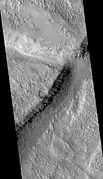 Mareotis Fossae Region, as seen by HiRISE.
Mareotis Fossae Region, as seen by HiRISE.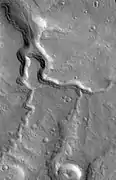 Tempe Fossae Sinuous Channel, as seen by HiRISE.
Tempe Fossae Sinuous Channel, as seen by HiRISE. Straight trough is a fossa that would be classified as a graben. Curved channels may have carried lava/water from the fossa. Picture taken with HiRISE under HiWish program.
Straight trough is a fossa that would be classified as a graben. Curved channels may have carried lava/water from the fossa. Picture taken with HiRISE under HiWish program. Troughs with dark slope streaks, as seen by HiRISE under HiWish program
Troughs with dark slope streaks, as seen by HiRISE under HiWish program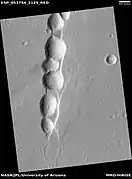 Line of pits, as seen by HiRISE under HiWish program Fossae often seem to start with a line of pits.
Line of pits, as seen by HiRISE under HiWish program Fossae often seem to start with a line of pits. Pits in shallow trough, as seen by HiRISE under HiWish program
Pits in shallow trough, as seen by HiRISE under HiWish program Troughs (Fossae), as seen by HiRISE under HiWish program
Troughs (Fossae), as seen by HiRISE under HiWish program Troughs (Fossae), as seen by HiRISE under HiWish program Trough seems to have cut away part of a crater.
Troughs (Fossae), as seen by HiRISE under HiWish program Trough seems to have cut away part of a crater. Channels coming from a trough, as seen by HiRISE under HiWish program
Channels coming from a trough, as seen by HiRISE under HiWish program
Dust devil tracks
Many areas on Mars, including the Arcadia quadrangle, experience the passage of giant dust devils. A thin coating of fine bright dust covers most of the Martian surface. When a dust devil goes by it blows away the coating and exposes the underlying dark surface. Dust devils have been seen from the ground and from orbit. They have even blown dust from the solar panels of the two Rovers on Mars, thereby greatly extending their lives.[13] The twin Rovers were designed to last for 3 months, instead they have lasted more than six years. The first Rover, Spirit, was last heard from in March 2010. Opportunity Rover is still exploring the Red Planet, after more than eight years. The pattern of the tracks have been shown to change every few months.[14] The image below from HiRISE shows some dust devil tracks in the shape of X's. You may need to click on the image for a larger view to see the tracks clearly.
 Tantalus Fossae, as seen by HiRISE. Click on image to see dust devil tracks.
Tantalus Fossae, as seen by HiRISE. Click on image to see dust devil tracks.
Dark slope streaks
Many places on Mars show dark streaks on steep slopes like crater walls. It seems that the youngest streaks are dark; then they become lighter with age. Often they begin as a small narrow spot then widen and extend downhill for hundreds of meters. They have been seen to travel around obstacles, like boulders.[15] Several ideas have been advanced to explain the streaks. Some involve water or even the growth of organisms.[16][17][18] [19] It is most generally accepted that they represent avalanches of dust. The streaks appear in areas covered with dust. When a thin layer of dust is removed, the underlying surface is dark. Much of the Martian surface is covered with dust. Fine dust settles out of the atmosphere covering everything. We know a lot about this dust because the solar panels of the Mars Rovers get covered with dust, thus reducing the electrical energy. The power of the Rovers has been restored many times by the wind, in the form of dust devils, cleaning the panels and boosting the power. So we know that dust falls from the atmosphere and is returned by dust devils over and over.[20] Dust storms are frequent, especially when the spring season begins in the southern hemisphere. At that time, Mars is 40% closer to the sun. The orbit of Mars is much more elliptical then the Earth's. That is the difference between the farthest point from the sun and the closest point to the sun is very great for Mars, but only a slight amount for the Earth. Also, every few years, the entire planet is engulfed in a global dust storm. When NASA's Mariner 9 craft arrived there, nothing could be seen through the dust storm.[21][22] Other global dust storms have also been observed, since that time.
Research, published in January 2012 in Icarus, found that dark streaks were initiated by airblasts from meteorites traveling at supersonic speeds. The team of scientists was led by Kaylan Burleigh, an undergraduate at the University of Arizona. After counting some 65,000 dark streaks around the impact site of a group of 5 new craters, patterns emerged. The number of streaks was greatest closer to the impact site. So, the impact somehow probably caused the streaks. Also, the distribution of the streaks formed a pattern with two wings extending from the impact site. The curved wings resembled scimitars, curved knives. This pattern suggests that an interaction of airblasts from the group of meteorites shook dust loose enough to start dust avalanches that formed the many dark streaks. At first it was thought that the shaking of the ground from the impact caused the dust avalanches, but if that was the case the dark streaks would have been arranged symmetrically around the impacts, rather than being concentrated into curved shapes.[23][24] Dark streaks can be seen in the image below of Tractus Catena that was taken by HiRISE.
 Tractus Catena, as seen by HiRISE. Scale bar is 1,000 meters long. Click on image for good view of dark slope streaks.
Tractus Catena, as seen by HiRISE. Scale bar is 1,000 meters long. Click on image for good view of dark slope streaks. Trough with dark slope streaks, as seen by HiRISE under HiWish program
Trough with dark slope streaks, as seen by HiRISE under HiWish program Dark slope streaks, as seen by HiRISE under HiWish program
Dark slope streaks, as seen by HiRISE under HiWish program Dark slope streaks in crater, as seen by HiRISE under HiWish program
Dark slope streaks in crater, as seen by HiRISE under HiWish program
Martian gullies
The Arcadia quadrangle is the location of gullies that may be due to recent flowing water. Gullies occur on steep slopes, especially on the walls of craters. Gullies are believed to be relatively young because they have few, if any craters. Moreover, they lie on top of sand dunes which themselves are considered to be quite young. Usually, each gully has an alcove, channel, and apron. Some studies have found that gullies occur on slopes that face all directions,[25] others have found that the greater number of gullies are found on poleward facing slopes, especially from 30-44 S.[26]
Although many ideas have been put forward to explain them,[27] the most popular involve liquid water coming from an aquifer, from melting at the base of old glaciers, or from the melting of ice in the ground when the climate was warmer.[28][29] Because of the good possibility that liquid water was involved with their formation and that they could be very young, scientists are excited. Maybe the gullies are where we should go to find life.
There is evidence for all three theories. Most of the gully alcove heads occur at the same level, just as one would expect of an aquifer. Various measurements and calculations show that liquid water could exist in aquifers at the usual depths where gullies begin.[28] One variation of this model is that rising hot magma could have melted ice in the ground and caused water to flow in aquifers. Aquifers are layer that allow water to flow. They may consist of porous sandstone. The aquifer layer would be perched on top of another layer that prevents water from going down (in geological terms it would be called impermeable). Because water in an aquifer is prevented from going down, the only direction the trapped water can flow is horizontally. Eventually, water could flow out onto the surface when the aquifer reaches a break—like a crater wall. The resulting flow of water could erode the wall to create gullies.[30] Aquifers are quite common on Earth. A good example is "Weeping Rock" in Zion National Park Utah.[31]
As for the next theory, much of the surface of Mars is covered by a thick smooth mantle that is thought to be a mixture of ice and dust.[32][33][34] This ice-rich mantle, a few yards thick, smoothes the land, but in places it has a bumpy texture, resembling the surface of a basketball. The mantle may be like a glacier and under certain conditions the ice that is mixed in the mantle could melt and flow down the slopes and make gullies.[35][36] Because there are few craters on this mantle, the mantle is relatively young. An excellent view of this mantle is shown below in the picture of the Ptolemaeus Crater Rim, as seen by HiRISE.[37] The ice-rich mantle may be the result of climate changes.[38] Changes in Mars's orbit and tilt cause significant changes in the distribution of water ice from polar regions down to latitudes equivalent to Texas. During certain climate periods water vapor leaves polar ice and enters the atmosphere. The water comes back to ground at lower latitudes as deposits of frost or snow mixed generously with dust. The atmosphere of Mars contains a great deal of fine dust particles. Water vapor will condense on the particles, then fall down to the ground due to the additional weight of the water coating. When Mars is at its greatest tilt or obliquity, up to 2 cm of ice could be removed from the summer ice cap and deposited at midlatitudes. This movement of water could last for several thousand years and create a snow layer of up to around 10 meters thick.[39][40] When ice at the top of the mantling layer goes back into the atmosphere, it leaves behind dust, which insulating the remaining ice.[41] Measurements of altitudes and slopes of gullies support the idea that snowpacks or glaciers are associated with gullies. Steeper slopes have more shade which would preserve snow.[26] Higher elevations have far fewer gullies because ice would tend to sublimate more in the thin air of the higher altitude.[42]
The third theory might be possible since climate changes may be enough to simply allow ice in the ground to melt and thus form the gullies. During a warmer climate, the first few meters of ground could thaw and produce a "debris flow" similar to those on the dry and cold Greenland east coast.[43] Since the gullies occur on steep slopes only a small decrease of the shear strength of the soil particles is needed to begin the flow. Small amounts of liquid water from melted ground ice could be enough.[44][45] Calculations show that a third of a mm of runoff can be produced each day for 50 days of each Martian year, even under current conditions.[46]
 A variety of gullies originating at different levels are visible in this HiRISE image that was taken under the HiWish program.
A variety of gullies originating at different levels are visible in this HiRISE image that was taken under the HiWish program. This enlargement of a small part of the previous image shows terraces along a gully channel. The terraces were created when a new channel cut through the old surface. This means that the gully was not in a single event. Water must have flowed more than once in this location.
This enlargement of a small part of the previous image shows terraces along a gully channel. The terraces were created when a new channel cut through the old surface. This means that the gully was not in a single event. Water must have flowed more than once in this location. Gullies in a crater. Some seem to be young, others are well developed. Picture was taken by HiRISE under the HiWish program.
Gullies in a crater. Some seem to be young, others are well developed. Picture was taken by HiRISE under the HiWish program.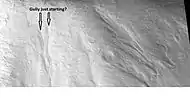 Gullies on a mound, as seen by HiRISE under HiWish program.
Gullies on a mound, as seen by HiRISE under HiWish program. Relatively young crater with possible gullies, as seen by HiRISE under HiWish program.
Relatively young crater with possible gullies, as seen by HiRISE under HiWish program. Gullies along mesa wall, as seen by HiRISE under HiWish program.
Gullies along mesa wall, as seen by HiRISE under HiWish program. Gullies along mesa wall in North Tempe Terra, as seen by HiRISE under HiWish program
Gullies along mesa wall in North Tempe Terra, as seen by HiRISE under HiWish program Close view of gully apron, as seen by HiRISE under HiWish program Note this is an enlargement of the previous image.
Close view of gully apron, as seen by HiRISE under HiWish program Note this is an enlargement of the previous image. Close view of gully alcove, as seen by HiRISE under HiWish program Note this is an enlargement of a previous image.
Close view of gully alcove, as seen by HiRISE under HiWish program Note this is an enlargement of a previous image. Gullies on wall of mesa, as seen by HiRISE under HiWish program
Gullies on wall of mesa, as seen by HiRISE under HiWish program
 Wide view of gullies, as seen by HiRISE under HiWish program
Wide view of gullies, as seen by HiRISE under HiWish program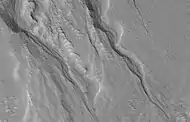 Close view of gullies, as seen by HiRISE under HiWish program
Close view of gullies, as seen by HiRISE under HiWish program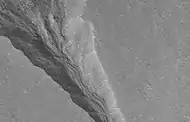 Close view of gully alcoves, as seen by HiRISE under HiWish program Polygons are visible.
Close view of gully alcoves, as seen by HiRISE under HiWish program Polygons are visible.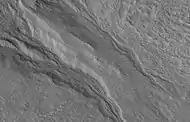 Close view of gullies, as seen by HiRISE under HiWish program Streamlined features are visible in gully channels.
Close view of gullies, as seen by HiRISE under HiWish program Streamlined features are visible in gully channels.
Latitude dependent mantle
Much of the surface of Mars is covered by a thick smooth mantle that is thought to be a mixture of ice and dust. This ice-rich mantle, a few yards thick, makes the surface look very smooth. Because there are few craters on this mantle, the mantle is relatively young.
Changes in Mars's orbit and tilt cause significant changes in the distribution of water ice from polar regions down to latitudes equivalent to Texas. During certain climate periods water vapor leaves polar ice and enters the atmosphere. The water returns to the ground at lower latitudes as deposits of frost or snow mixed generously with dust. The atmosphere of Mars contains a great deal of fine dust particles. Water vapor condenses on the particles, and then they fall down to the ground due to the additional weight of the water coating. When ice at the top of the mantling layer goes back into the atmosphere, it leaves behind dust, which insulates the remaining ice.[47]
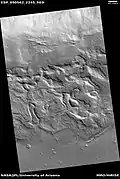 Wide view of surface with spots displaying mantle, as seen by HiRISE under HiWish program
Wide view of surface with spots displaying mantle, as seen by HiRISE under HiWish program Close views of mantle, as seen by HiRISE under HiWish program
Close views of mantle, as seen by HiRISE under HiWish program Close views of mantle, as seen by HiRISE under HiWish program
Close views of mantle, as seen by HiRISE under HiWish program
 Wide view of surface with spots displaying mantle, as seen by HiRISE under HiWish program
Wide view of surface with spots displaying mantle, as seen by HiRISE under HiWish program Close view of mantle, as seen by HiRISE under HiWish program
Close view of mantle, as seen by HiRISE under HiWish program Close view of mantle, as seen by HiRISE under HiWish program
Close view of mantle, as seen by HiRISE under HiWish program Wide view of crater with layers and mantle in places, as seen by HiRISE under HiWish program
Wide view of crater with layers and mantle in places, as seen by HiRISE under HiWish program Close view of mantle, as seen by HiRISE under HiWish program
Close view of mantle, as seen by HiRISE under HiWish program Close view of mantle, as seen by HiRISE under HiWish program
Close view of mantle, as seen by HiRISE under HiWish program Mantle and mantle layers, as seen by HiRISE under HiWish program To the left part of the picture mantle layers seem to have formed dipping layers.
Mantle and mantle layers, as seen by HiRISE under HiWish program To the left part of the picture mantle layers seem to have formed dipping layers.
Glacial features
Glaciers, loosely defined as patches of currently or recently flowing ice, are thought to be present across large but restricted areas of the modern Martian surface, and are inferred to have been more widely distributed at times in the past.[48][22] Lobate convex features on the surface known as viscous flow features and lobate debris aprons, which show the characteristics of non-Newtonian flow, are now almost unanimously regarded as true glaciers.[48][49][50][51][52][53][54][55][56]
 Glacier, as seen by HiRISE under HiWish program
Glacier, as seen by HiRISE under HiWish program View of lobate debris apron along a slope. Lobate debris aprons are considered to be glaciers covered with a layer of debris. Image located in Arcadia quadrangle.
View of lobate debris apron along a slope. Lobate debris aprons are considered to be glaciers covered with a layer of debris. Image located in Arcadia quadrangle.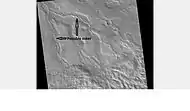 Esker, as seen by HiRISE under the HiWish program Eskers form when a stream runs under a glacier.
Esker, as seen by HiRISE under the HiWish program Eskers form when a stream runs under a glacier. Lobate debris apron (LDA) around a mound, as seen by HiRISE under the HiWish program
Lobate debris apron (LDA) around a mound, as seen by HiRISE under the HiWish program
Channels
Many places on Mars show channels of different sizes. Many of these channels probably carried water, at least for a time. The climate of Mars may have been such in the past that water ran on its surface. It has been known for some time that Mars undergoes many large changes in its tilt or obliquity because its two small moons lack the gravity to stabilize it, as our moon stabilizes Earth; at times the tilt of Mars has even been greater than 80 degrees[57][58]
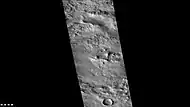 Perepelkin (Martian crater), as seen by CTX camera (on Mars Reconnaissance Orbiter).
Perepelkin (Martian crater), as seen by CTX camera (on Mars Reconnaissance Orbiter).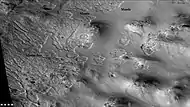 Channels and mantle, as seen by CTX camera (on Mars Reconnaissance Orbiter). Channels are exposed where the mantle has disappeared. Mantle falls from the sky during certain climates. Note: this is an enlargement of the previous image of Perepelkin Crater.
Channels and mantle, as seen by CTX camera (on Mars Reconnaissance Orbiter). Channels are exposed where the mantle has disappeared. Mantle falls from the sky during certain climates. Note: this is an enlargement of the previous image of Perepelkin Crater. Channels, as seen by HiRISE under HiWish program. Stream appears to have eroded through a hill.
Channels, as seen by HiRISE under HiWish program. Stream appears to have eroded through a hill. Channel, as seen by HiRISE under HiWish program Arrow points to a crater that was probably eroded by flowing water.
Channel, as seen by HiRISE under HiWish program Arrow points to a crater that was probably eroded by flowing water. Channel that went across trough, as seen by HiRISE under HiWish program
Channel that went across trough, as seen by HiRISE under HiWish program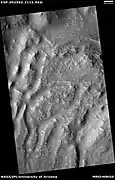 Channels, as seen by HiRISE under HiWish program
Channels, as seen by HiRISE under HiWish program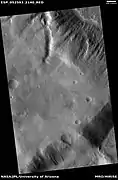 Channels, as seen by HiRISE under HiWish program
Channels, as seen by HiRISE under HiWish program Channels, as seen by HiRISE under HiWish program
Channels, as seen by HiRISE under HiWish program Channels, as seen by HiRISE under HiWish program
Channels, as seen by HiRISE under HiWish program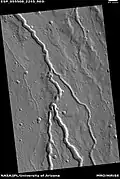 Channels, as seen by HiRISE under HiWish program
Channels, as seen by HiRISE under HiWish program Channels, as seen by HiRISE under HiWish program The channel in places seems to disappear and then reappear. Water was probably flowing underground.
Channels, as seen by HiRISE under HiWish program The channel in places seems to disappear and then reappear. Water was probably flowing underground.
Tilted layers
Tilted layers along slopes, especially along crater walls are believed to be the remains of a once wide spread material that has mostly been eroded away.[59]
 Wide view of slopes that contain tilted layered features, as seen by HiRISE under HiWish program
Wide view of slopes that contain tilted layered features, as seen by HiRISE under HiWish program Close view of slopes that contain tilted layered features, as seen by HiRISE under HiWish program Note: this is an enlargement from the previous image.
Close view of slopes that contain tilted layered features, as seen by HiRISE under HiWish program Note: this is an enlargement from the previous image. Close view of slopes that contain tilted layered features, as seen by HiRISE under HiWish program Note: this is an enlargement from the previous image.
Close view of slopes that contain tilted layered features, as seen by HiRISE under HiWish program Note: this is an enlargement from the previous image.
Linear ridge networks
Linear ridge networks are found in various places on Mars in and around craters.[60] These features have also been called "polygonal ridge networks," "boxwork ridges", and "reticulate ridges."[61] Ridges often appear as mostly straight segments that intersect in a lattice-like manner. They are hundreds of meters long, tens of meters high, and several meters wide. It is thought that impacts created fractures in the surface, these fractures later acted as channels for fluids. Fluids cemented the structures. With the passage of time, surrounding material was eroded away, thereby leaving hard ridges behind.
 Wide view of ridge network, as seen by HiRISE under HiWish program
Wide view of ridge network, as seen by HiRISE under HiWish program Close view of ridge networks, as seen by HiRISE under HiWish program Arrow points to small, straight ridge.
Close view of ridge networks, as seen by HiRISE under HiWish program Arrow points to small, straight ridge. Close view of small and large ridges, as seen by HiRISE under HiWish program
Close view of small and large ridges, as seen by HiRISE under HiWish program Close view of small and large ridges, as seen by HiRISE under HiWish program
Close view of small and large ridges, as seen by HiRISE under HiWish program
Layers
Many places on Mars show rocks arranged in layers. Rock can form layers in a variety of ways. Volcanoes, wind, or water can produce layers.[62] A detailed discussion of layering with many Martian examples can be found in Sedimentary Geology of Mars.[63]
 Layers, as seen by HiRISE under HiWish program
Layers, as seen by HiRISE under HiWish program Layers, as seen by HiRISE under HiWish program Location is Tempe Terra
Layers, as seen by HiRISE under HiWish program Location is Tempe Terra Layers, as seen by HiRISE under HiWish program Location is Tempe Terra Note: this is an enlargement of the previous image.
Layers, as seen by HiRISE under HiWish program Location is Tempe Terra Note: this is an enlargement of the previous image.
 Wide view of crater with layers near the top, as seen by HiRISE under HiWish program
Wide view of crater with layers near the top, as seen by HiRISE under HiWish program Close, color view of layers near top of crater, as seen by HiRISE under HiWish program
Close, color view of layers near top of crater, as seen by HiRISE under HiWish program Wide view of layers in a trough, as seen by HiRISE under HiWish program
Wide view of layers in a trough, as seen by HiRISE under HiWish program Close view of layers and boulders in the wall of a trough, as seen by HiRISE under HiWish program
Close view of layers and boulders in the wall of a trough, as seen by HiRISE under HiWish program Close, color view of layers in a trough, as seen by HiRISE under HiWish program
Close, color view of layers in a trough, as seen by HiRISE under HiWish program
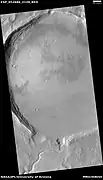 Crater with channels and ridges, as seen by HiRISE under HiWish program
Crater with channels and ridges, as seen by HiRISE under HiWish program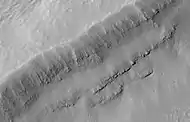 Layers on crater wall, as seen by HiRISE under HiWish program
Layers on crater wall, as seen by HiRISE under HiWish program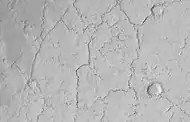 Ridges on crater floor, as seen by HiRISE under HiWish program
Ridges on crater floor, as seen by HiRISE under HiWish program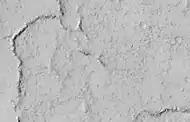 Close view of ridges on crater floor, as seen by HiRISE under HiWish program Ridges are seen to be breaking up into boulders.
Close view of ridges on crater floor, as seen by HiRISE under HiWish program Ridges are seen to be breaking up into boulders. Lava flows, as seen by HiRISE under HiWish program
Lava flows, as seen by HiRISE under HiWish program
Other Features in the Arcadia quadrangle
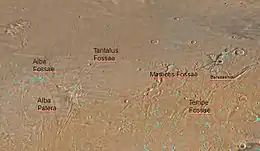 Map of Arcadia quadrangle with major features labeled. Several large cracks called Fossae are in this area.
Map of Arcadia quadrangle with major features labeled. Several large cracks called Fossae are in this area.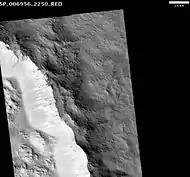 Impact Crater on Northern edge of Alba Patera, as seen by HiRISE. Scale bar is 1 km long.
Impact Crater on Northern edge of Alba Patera, as seen by HiRISE. Scale bar is 1 km long. Double crater, as seen by HiRISE under HiWish program
Double crater, as seen by HiRISE under HiWish program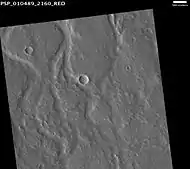 Enipeus Vallis, as seen by HiRISE. Scale bar is 500 meters long.
Enipeus Vallis, as seen by HiRISE. Scale bar is 500 meters long.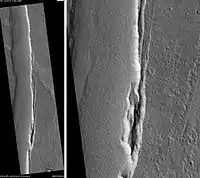 Artynia Catena, as seen by HiRISE. Scale bar is 1000 meters long.
Artynia Catena, as seen by HiRISE. Scale bar is 1000 meters long. Hollows formed by erosion on floor of crater, as seen by HiRISE under HiWish program.
Hollows formed by erosion on floor of crater, as seen by HiRISE under HiWish program.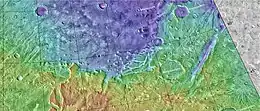 Map showing location of Barabashov Crater and other nearby craters.
Map showing location of Barabashov Crater and other nearby craters. MOLA and CTX image of Barabashov Crater
MOLA and CTX image of Barabashov Crater Wide view of craters, layers, streaks, hollows Picture taken with HiRISE under HiWish program
Wide view of craters, layers, streaks, hollows Picture taken with HiRISE under HiWish program Close view of hollows, as seen by HiRISE under HiWish program
Close view of hollows, as seen by HiRISE under HiWish program
Other Mars quadrangles
Interactive Mars map
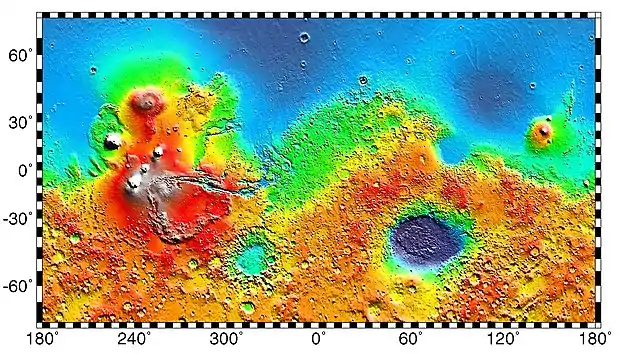
See also
References
- Davies, M.E.; Batson, R.M.; Wu, S.S.C. "Geodesy and Cartography" in Kieffer, H.H.; Jakosky, B.M.; Snyder, C.W.; Matthews, M.S., Eds. Mars. University of Arizona Press: Tucson, 1992.
- Distances calculated using NASA World Wind measuring tool. http://worldwind.arc.nasa.gov/.
- Approximated by integrating latitudinal strips with area of R^2 (L1-L2)(cos(A)dA) from 30° to 65° latitude; where R = 3889 km, A is latitude, and angles expressed in radians. See: https://stackoverflow.com/questions/1340223/calculating-area-enclosed-by-arbitrary-polygon-on-earths-surface.
- Blunck, J. 1982. Mars and its Satellites. Exposition Press. Smithtown, N.Y.
- USGS Gazetteer of Planetary Nomenclature. Mars. http://planetarynames.wr.usgs.gov/.
- "Mars Art Gallery Martian Feature Name Nomenclature".
- Skinner, J., L. Skinner, and J. Kargel. 2007. Re-assessment of Hydrovolcanism-based Resurfacing within the Galaxias Fossae Region of Mars. Lunar and Planetary Science XXXVIII (2007)
- "HiRISE | Craters and Pit Crater Chains in Chryse Planitia (PSP_008641_2105)".
- Wyrick, D., D. Ferrill, D. Sims, and S. Colton. 2003. Distribution, Morphology and Structural Associations of Martian Pit Crater Chains. Lunar and Planetary Science XXXIV (2003)
- http://www.swri.edu/4org/d20/DEMPS/planetgeo/planetmars.html%5B%5D
- "Mars Global Surveyor MOC2-620 Release".
- Ferrill, D., D. Wyrick, A. Morris, D. Sims, and N. Franklin. 2004. Dilational fault slip and pit chain formation on Mars 14:10:4-12
- "Mars Exploration Rover".
- "Archived copy". Archived from the original on 2011-10-28. Retrieved 2012-01-19.CS1 maint: archived copy as title (link)
- http://www.space.com/image_of_day_080730.html%5B%5D
- "Archived copy". Archived from the original on 2015-02-21. Retrieved 2011-03-28.CS1 maint: archived copy as title (link)
- http://www.space.com/scienceastronomy/streaks_mars_streaks_030328.html%5B%5D
- http://www.space.com/scienceastronomy/mars_%5B%5D
- http://www.space.com/scienceastronomy/streaks_mars_021200.html
- "Mars Spirit Rover Gets Energy Boost From Cleaner Solar Panels". Science Daily. 2009-02-19. Retrieved 2017-06-01.
- Moore, Patrick (1990-06-02). Atlas of the Solar System. ISBN 0-517-00192-6.
- Hugh H. Kieffer (1992). Mars. University of Arizona Press. ISBN 978-0-8165-1257-7. Retrieved 7 March 2011.
- Burleigh, Kaylan J.; Melosh, Henry J.; Tornabene, Livio L.; Ivanov, Boris; McEwen, Alfred S.; Daubar, Ingrid J. (2012). "Impact air blast triggers dust avalanches on Mars". Icarus. 217 (1): 194. Bibcode:2012Icar..217..194B. doi:10.1016/j.icarus.2011.10.026.
- "Red Planet Report | What's new with Mars".
- Edgett, K.; et al. (2003). "Polar-and middle-latitude martian gullies: A view from MGS MOC after 2 Mars years in the mapping orbit" (PDF). Lunar Planet. Sci. 34. Abstract 1038. Bibcode:2003LPI....34.1038E.
- Dickson, J; Head, J; Kreslavsky, M (2007). "Martian gullies in the southern mid-latitudes of Mars: Evidence for climate-controlled formation of young fluvial features based upon local and global topography" (PDF). Icarus. 188 (2): 315–323. Bibcode:2007Icar..188..315D. doi:10.1016/j.icarus.2006.11.020.
- http://www.psrd.hawaii.edu/Aug03/MartianGullies.html
- Heldmann, J (2004). "Observations of martian gullies and constraints on potential formation mechanisms". Icarus. 168 (2): 285–304. Bibcode:2004Icar..168..285H. doi:10.1016/j.icarus.2003.11.024.
- Forget, F. et al. 2006. Planet Mars Story of Another World. Praxis Publishing. Chichester, UK.
- "Mars Gullies Likely Formed by Underground Aquifers".
- Harris, A and E. Tuttle. 1990. Geology of National Parks. Kendall/Hunt Publishing Company. Dubuque, Iowa
- Malin, Michael C.; Edgett, Kenneth S. (2001). "Mars Global Surveyor Mars Orbiter Camera: Interplanetary cruise through primary mission". Journal of Geophysical Research. 106 (E10): 23429–23570. Bibcode:2001JGR...10623429M. doi:10.1029/2000JE001455. S2CID 129376333.
- Mustard, JF; Cooper, CD; Rifkin, MK (2001). "Evidence for recent climate change on Mars from the identification of youthful near-surface ground ice" (PDF). Nature. 412 (6845): 411–4. Bibcode:2001Natur.412..411M. doi:10.1038/35086515. PMID 11473309. S2CID 4409161.
- Carr, Michael H. (2001). "Mars Global Surveyor observations of Martian fretted terrain". Journal of Geophysical Research. 106 (E10): 23571–23595. Bibcode:2001JGR...10623571C. doi:10.1029/2000JE001316.
- NBC News
- Head, J. W.; Marchant, D. R.; Kreslavsky, M. A. (2008). "From the Cover: Formation of gullies on Mars: Link to recent climate history and insolation microenvironments implicate surface water flow origin". Proceedings of the National Academy of Sciences. 105 (36): 13258–63. Bibcode:2008PNAS..10513258H. doi:10.1073/pnas.0803760105. PMC 2734344. PMID 18725636.
- Christensen, PR (2003). "Formation of recent martian gullies through melting of extensive water-rich snow deposits". Nature. 422 (6927): 45–8. Bibcode:2003Natur.422...45C. doi:10.1038/nature01436. PMID 12594459. S2CID 4385806.
- http://news.nationalgeographic.com/news/2008/03/080319-mars-gullies_2.html
- Jakosky, Bruce M.; Carr, Michael H. (1985). "Possible precipitation of ice at low latitudes of Mars during periods of high obliquity". Nature. 315 (6020): 559–561. Bibcode:1985Natur.315..559J. doi:10.1038/315559a0. S2CID 4312172.
- Jakosky, Bruce M.; Henderson, Bradley G.; Mellon, Michael T. (1995). "Chaotic obliquity and the nature of the Martian climate". Journal of Geophysical Research. 100 (E1): 1579–1584. Bibcode:1995JGR...100.1579J. doi:10.1029/94JE02801.
- MLA NASA/Jet Propulsion Laboratory (December 18, 2003). "Mars May Be Emerging From An Ice Age". ScienceDaily. Retrieved February 19, 2009.
- Hecht, M (2002). "Metastability of liquid water on Mars" (PDF). Icarus. 156 (2): 373–386. Bibcode:2002Icar..156..373H. doi:10.1006/icar.2001.6794.
- Peulvast, J.P. (1988). "Mouvements verticaux et genèse du bourrelet Est-groenlandais. dans la région de Scoresby Sund". Physio Géo (in French). 18: 87–105.
- Costard, F.; et al. (2001). "Debris Flows on Mars: Analogy with Terrestrial Periglacial Environment and Climatic Implications" (PDF). Lunar and Planetary Science. XXXII: 1534. Bibcode:2001LPI....32.1534C.
- http://www.spaceref.com:16090/news/viewpr.html?pid=7124%5B%5D,
- Clow, G (1987). "Generation of liquid water on Mars through the melting of a dusty snowpack". Icarus. 72 (1): 93–127. Bibcode:1987Icar...72...95C. doi:10.1016/0019-1035(87)90123-0.
- MLA NASA/Jet Propulsion Laboratory (December 18, 2003). "Mars May Be Emerging From An Ice Age". ScienceDaily. Retrieved February 19, 2009.
- "The Surface of Mars" Series: Cambridge Planetary Science (No. 6) ISBN 978-0-511-26688-1 Michael H. Carr, United States Geological Survey, Menlo Park
- Milliken, R. E.; Mustard, J. F.; Goldsby, D. L. (2003). "Viscous flow features on the surface of Mars: Observations from high-resolution Mars Orbiter Camera (MOC) images". Journal of Geophysical Research. 108 (E6): 5057. Bibcode:2003JGRE..108.5057M. doi:10.1029/2002je002005. S2CID 12628857.
- Squyres, S.W.; Carr, M.H. (1986). "Geomorphic evidence for the distribution of ground ice on Mars". Science. 213 (4735): 249–253. Bibcode:1986Sci...231..249S. doi:10.1126/science.231.4735.249. PMID 17769645. S2CID 34239136.
- Head, J.W.; Marchant, D.R.; Dickson, J.L.; Kress, A.M. (2010). "Criteria for the recognition of debris-covered glacier and valley glacier landsystem deposits". Earth Planet. Sci. Lett. 294: 306–320. Bibcode:2010E&PSL.294..306H. doi:10.1016/j.epsl.2009.06.041.
- Holt, J.W.; et al. (2008). "Radar sounding evidence for buried glaciers in the southern mid-latitudes of Mars". Science. 322 (5905): 1235–1238. Bibcode:2008Sci...322.1235H. doi:10.1126/science.1164246. PMID 19023078. S2CID 36614186.
- Morgan, G.A.; Head, J.W.; Marchant, D.R. (2009). "Lineated valley fill (LVF) and lobate debris aprons (LDA) in the Deuteronilus Mensae northern dichotomy boundary region, Mars: Constraints on the extent, age and episodicity of Amazonian glacial events". Icarus. 202 (1): 22–38. Bibcode:2009Icar..202...22M. doi:10.1016/j.icarus.2009.02.017.
- Plaut, J.J.; Safaeinili, A.; Holt, J.W.; Phillips, R.J.; Head, J.W.; Sue, R.; Putzig, A. (2009). "Frigeri Radar evidence for ice in lobate debris aprons in the mid-northern latitudes of Mars". Geophys. Res. Lett. 36 (2): L02203. Bibcode:2009GeoRL..36.2203P. doi:10.1029/2008gl036379. S2CID 17530607.
- Baker, D.M.H.; Head, J.W.; Marchant, D.R. (2010). "Flow patterns of lobate debris aprons and lineated valley fill north of Ismeniae Fossae, Mars: Evidence for extensive mid-latitude glaciation in the Late Amazonian". Icarus. 207 (1): 186–209. Bibcode:2010Icar..207..186B. doi:10.1016/j.icarus.2009.11.017.
- Arfstrom, J. (2005). "Terrestrial analogs and interrelationships". Icarus. 174 (2): 321–335. Bibcode:2005Icar..174..321A. doi:10.1016/j.icarus.2004.05.026.
- name; Touma, J.; Wisdom, J. (1993). "The Chaotic Obliquity of Mars". Science. 259 (5099): 1294–1297. Bibcode:1993Sci...259.1294T. doi:10.1126/science.259.5099.1294. PMID 17732249. S2CID 42933021.
- Laskar, J.; Correia, A.; Gastineau, M.; Joutel, F.; Levrard, B.; Robutel, P. (2004). "Long term evolution and chaotic diffusion of the insolation quantities of Mars". Icarus. 170 (2): 343–364. Bibcode:2004Icar..170..343L. CiteSeerX 10.1.1.635.2720. doi:10.1016/j.icarus.2004.04.005.
- Carr, M (2001). "Mars Global Surveyor observations of martian fretted terrain". J. Geophys. Res. 106: 23571–23593. Bibcode:2001JGR...10623571C. doi:10.1029/2000je001316.
- Head, J., J. Mustard. 2006. Breccia dikes and crater-related faults in impact craters on Mars: Erosion and exposure on the floor of a crater 75 km in diameter at the dichotomy boundary, Meteorit. Planet Science: 41, 1675-1690.
- Moore, J., D. Wilhelms. 2001. Hellas as a possible site of ancient ice-covered lakes on Mars. Icarus: 154, 258-276.
- "HiRISE | High Resolution Imaging Science Experiment". Hirise.lpl.arizona.edu?psp_008437_1750. Retrieved 2012-08-04.
- Grotzinger, J. and R. Milliken (eds.). 2012. Sedimentary Geology of Mars. SEPM.
- Morton, Oliver (2002). Mapping Mars: Science, Imagination, and the Birth of a World. New York: Picador USA. p. 98. ISBN 0-312-24551-3.
- "Online Atlas of Mars". Ralphaeschliman.com. Retrieved December 16, 2012.
- "PIA03467: The MGS MOC Wide Angle Map of Mars". Photojournal. NASA / Jet Propulsion Laboratory. February 16, 2002. Retrieved December 16, 2012.
- "Online Atlas of Mars". Ralphaeschliman.com. Retrieved December 16, 2012.
- "PIA03467: The MGS MOC Wide Angle Map of Mars". Photojournal. NASA / Jet Propulsion Laboratory. February 16, 2002. Retrieved December 16, 2012.
